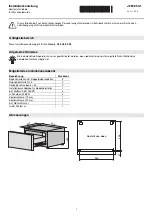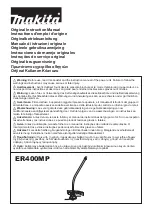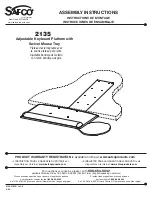
6
3. Add the Btu/Hr of all fuel burning appliances in the
space.
Vent-free log set _______________ Btu/Hr
Gas water heater* ______________ Btu/Hr
Gas furnace ___________________ Btu/Hr
Vented gas heater ______________ Btu/Hr
Gas fireplace logs
______________ Btu/Hr
Other gas appliances* + ________ Btu/Hr
Total = ________ Btu/Hr
* Do not include direct-vent gas appliances. Direct-vent
draws combustion air from the outdoors and vents to
the outdoors.
Example:
Vent-free log set ______________ Btu/Hr
Gas water heater* _____________ Btu/Hr
Total = ________ Btu/Hr
4. Compare the maximum Btu/Hr the space can support with
the actual amount of Btu/Hr used.
____ Btu/Hr (max. the space can support)
____ Btu/Hr (actual amt. of Btu/Hr used)
Example: 63,300 Btu/Hr (maximum the space can sup-
port)
73,000 Btu/Hr (actual amount of Btu/Hr used)
The space in the above example is a
confined
space because
the actual Btu/Hr used is more than the maximum Btu/Hr
the space can support. You must provide additional fresh
air. Your options are as follows:
A. Rework work sheet, adding the space of an adjoining room.
If the extra space provides an
unconfined
space, remove
door to adjoining room or add ventilation grills between
rooms. See Ventilation Air from Inside Building, page 5.
B. Vent room directly to the outdoors. See Ventilation Air
from Outdoors, page 5.
C. Install a lower Btu/Hr appliance, if lower Btu/Hr size
makes room unconfined.
If the actual Btu/Hr used is less than the maximum Btu/Hr
the space can support, the space is an
unconfined
space.
You will need no additional fresh air ventilation.
39,000
40,000
79,000
AIR FOR COMBUSTION
AND VENTILATION
WARNING: If the area in which the
heater may be operated does not meet the
required volume for indoor combustion
air,combustion and ventilation air shall be
provided by one of the methods described
intheNationalFuelGasCode,ANSIZ223.1/
NFPA 54, the International Fuel Gas Code,
or applicable local codes.
CONTINUED
VENTED OPERATION
Note: When used as a vented heater, appliance must be
installed only in a solid-fuel burning fireplace with a
working flue and constructed of noncombustible mat-
erial.
Area of Various Standard
Round Flues
Diameter (ins.)
Area (sq. ins.)
5"
20 sq. inches
6"
29 sq. inches
7"
39 sq. inches
8"
51 sq. inches
Follow instructions
Installing Damper Clamp
on
page 8 for location of damper in the fireplace.
Damper
Clamp
Damper
Chimney
Minimum Permanent
Height (ft.) Flue Opening (sq. ins.)
6' to 15'
39 sq. inches
15' to 30'
29 sq. inches
Figure 2 - Damper Clamp
The
Nationa
l
FuelGasCode
,
A N SI Z223.1/NFPA 54
defines a confined space as a space
whose volume is less than 50 ft
3
per 1000btu/hr (4.8 m
3
per kw) of the aggregate input
of all appliances installed in that space. Rooms communicating directly with the space
in which the appliances are installed, through openings not furnished with doors are
considered a part of the unconfined space.
You may also use this heater as a vented product. There are
three reasons for operating your heater in the vented mode.
1. The fireplace does not meet the clearance to com-
bustibles requirements for vent-free operation.
2. State or local codes do not permit vent-free operation.
3. You prefer vented operation.
manently open chimney flue damper. You must install the
damper clamp. This will insure vented operation (see Fig-
u r e 3 on page 8). The damper clamp will keep damper
opening
you must provide. Attach damper clamp so the minimum
permanentflue opening will be maintained at all times.
open. See chart below for minimum permanent flue
If reasons number 1 or 2 above apply to you, you must per-
Summary of Contents for Premier Estate PEVFR18LP
Page 11: ...Figure 7 Log Placement Savannah Oak 18 ...
Page 12: ...Figure 8 Log Placement Savannah Oak 24 and 30 ...
Page 20: ...20 ...
Page 21: ...21 ...







































